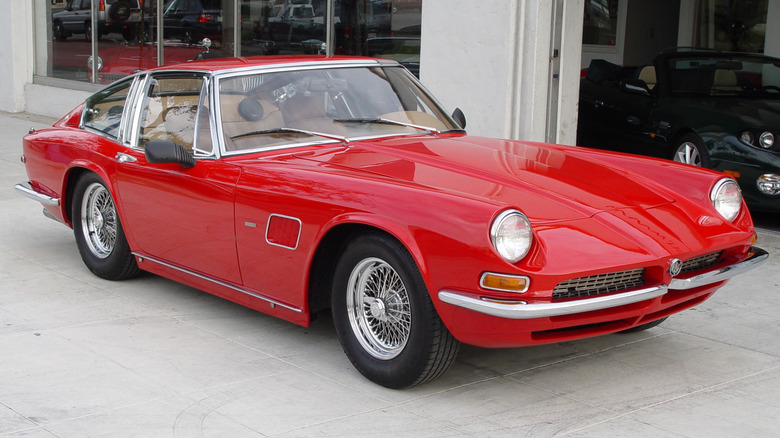
EmmanuelD/Wikimedia Commons
When it comes to affordable, reliable power, it’s always been difficult to beat an American V8. Long-running favorites from the likes of GM, Chrysler, and Ford might lack the exotic prestige that comes with a low-volume handbuilt European powertrain, but there’s a good reason they have remained so popular. Likewise, there’s a good reason why British cars have a long standing reputation for being unreliable. Sure, there are some exceptions, but overall, a much larger number of British cars have fit the stereotype than have defied it.
Advertisement
The idea of combining reliable American power with British handling and engineering is far from a novel one, and has been immortalized by the likes of the Shelby Cobra. However, there are plenty more British classics that feature American V8 hearts, many of which get overlooked by enthusiasts today. From long-distance luxury cruisers to Cobra-rivaling muscle cars, these cars all offered their own spin on the British-American formula, although many have since been forgotten about by enthusiasts.
[Featured image by EmmanuelD via Wikimedia Commons | Cropped and scaled | Public Domain]
Jensen Interceptor
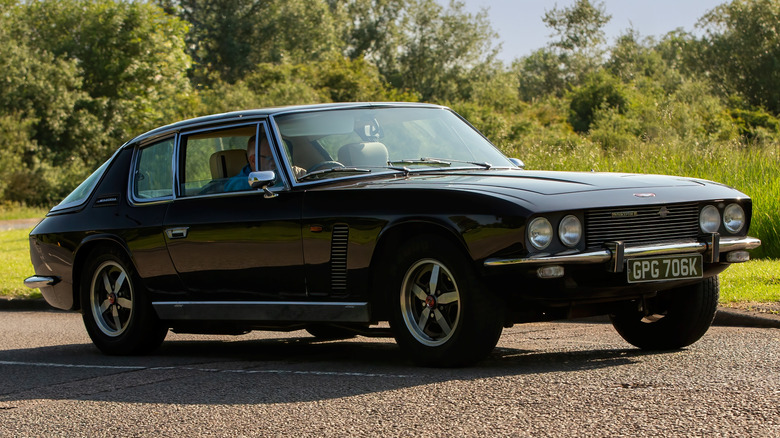
Sue Thatcher/Shutterstock
Although it always remained a niche brand in America, Jensen Motors is one of the most notable defunct names in the British classic car world. Its most famous model was the Interceptor, a British muscle car with a Chrysler V8 engine at its heart. The Interceptor was first introduced in 1966 and featured a 383 (6.3L) V8 at launch, with later models switching to a larger 440 (7.2L) unit. A four-wheel-drive offshoot of the model, called the FF, was also available.
Advertisement
The car remained in production until 1976, when financial issues saw the company fold entirely. Several revivals were attempted in the decades following its collapse, but none were successful. However, a specialist outfit called Jensen International Automotive restores and upgrades Interceptors today at a cost of £390,000 (around $515,000). Most examples don’t go for anywhere near that figure, and can be readily picked up for under $50,000.
The Interceptor might have been British in its construction, but its design was handled by the Italians. Its bodywork was originally penned by Carrozzeria Touring and the earliest models were partially assembled in Italy, although most were constructed at Jensen’s facility in West Bromwich, England. While rivals from the era like the Aston Martin V8 Vantage have risen dramatically in value in the decades since they rolled off the production lines, the Interceptor remains a comparatively overlooked part of British performance car history. However, that’s helped keep used values reasonable for those in the know.
Advertisement
Sunbeam Tiger
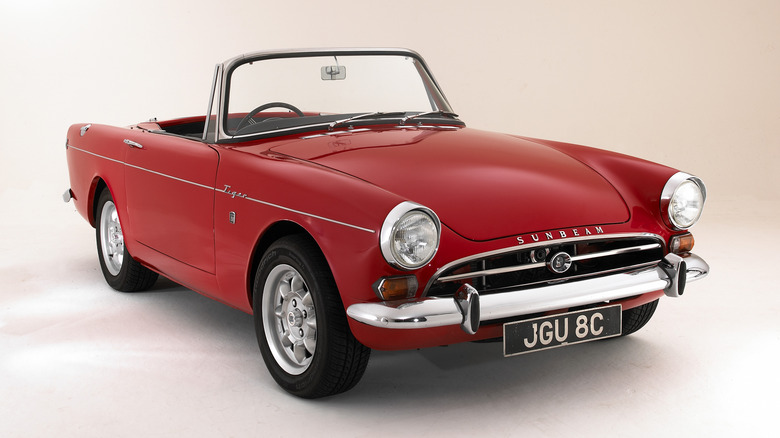
Heritage Images/Getty Images
The AC Cobra is by far the most famous example of combining the chassis of a small British sports car with a powerful Ford V8 engine, but it’s not the only model to follow the formula. The Sunbeam Tiger also did the same thing, taking the chassis of a Sunbeam Alpine — which usually featured a four-cylinder engine — and cramming in either a 260 or 289 Ford V8. The prototype of the Tiger was even built by none other than Carroll Shelby.
Advertisement
Production of the car was entrusted to Jensen, with Alpine chassis being shipped to the latter’s factory and hastily adapted to fit a V8 engine. Production quality was notoriously poor, and today one of the best ways to spot an original Tiger is to look for specific dents in the chassis that were common byproducts of Jensen’s rough and ready «adaptation» process.
MkI Tigers arrived in dealerships for the 1964 model year, with early cars sporting 260 (4.3L) V8 engines. The more powerful MkII cars arrived in 1966 and boasted the 289 (4.7L) V8 with 200 horsepower on tap. A total of 7,003 examples were reportedly built across the car’s lifespan, with production ending in 1967. Earlier that year, Chrysler had acquired Sunbeam’s parent company, the Rootes Group, and so blocked Sunbeam from acquiring new Ford engines. Chrysler’s V8 couldn’t be squeezed into the Tiger’s engine bay, and so the model was discontinued.
Advertisement
Bristol 411
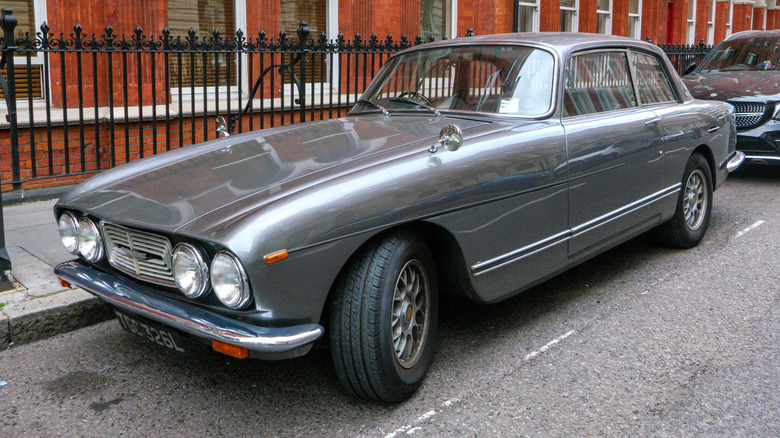
phaustov/Shutterstock
One of the most exclusive British classic car marques, Bristol remained an oddity in the automotive world throughout its existence. It was originally formed after World War II as a division of Bristol Aeroplane Company, with the intention of providing a new source of revenue for the business after military aircraft orders dried up. It was eventually split off as a separate entity and forged a reputation as one of the leading luxury carmakers of its day, competing against the likes of Aston Martin and Bentley.
Advertisement
The 411 was the brand’s first V8 powered car, with previous Bristol models using a BMW-derived six-cylinder engine. It featured a Chrysler 400 (6.6L) V8, reportedly because it was built in Canada rather than the USA. That made it more acceptable to Bristol bosses than an equivalent U.S.-built unit from Ford or GM, since Canada was part of the British Commonwealth.
Bristol’s cars were made with consistently high levels of build quality, defying the British car stereotype. They were only ever produced in extremely low numbers — although exact figures aren’t known — and part of that was down to their high prices. Production ran from 1969 to 1976, and despite their advancing age, many remain in active use. According to Autocar, roughly 90% of 411s in the U.K. are used as daily drivers. That’s typical of the eccentric buyers that Bristol attracts, but it’s this eccentricity that has kept the brand — and the 411 — alive despite decades of obscurity.
Advertisement
Gordon-Keeble GT
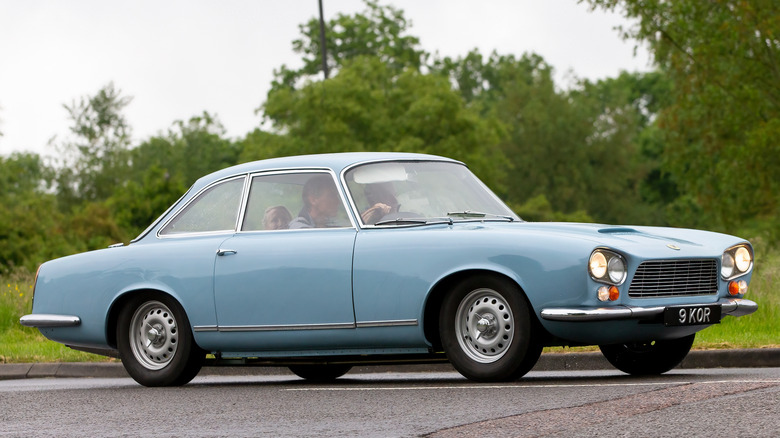
Sue Thatcher/Shutterstock
British carmaking history is filled with promising but short-lived marques that ran out of cash before managing to really get off the ground. Gordon-Keeble is one such company, with its first GT prototype unveiled in 1960 to a highly positive critical reception. It combined a Chevy 327 (5.4L) V8 engine with British engineering and bodywork designed by a young Giorgetto Giugiaro. Although it was primarily built as a grand tourer, it was a fiercely fast one, with a top speed reportedly north of 140 mph.
Advertisement
It’s thought that around 100 examples of the car were built in total, with financial issues putting an abrupt end to production. Like any startup car company, Gordon-Keeble’s funds were tight, and by 1965 the fledgling outfit had gone bankrupt. Over the following years, the company tried to restart production, but was mostly unsuccessful. The marque retains a fanbase in the U.K. and as a result many examples of the Gordon-Keeble survive, but its rarity and short production life means that the car has been forgotten about by most enthusiasts outside of that core circle.
AC 428 Frua
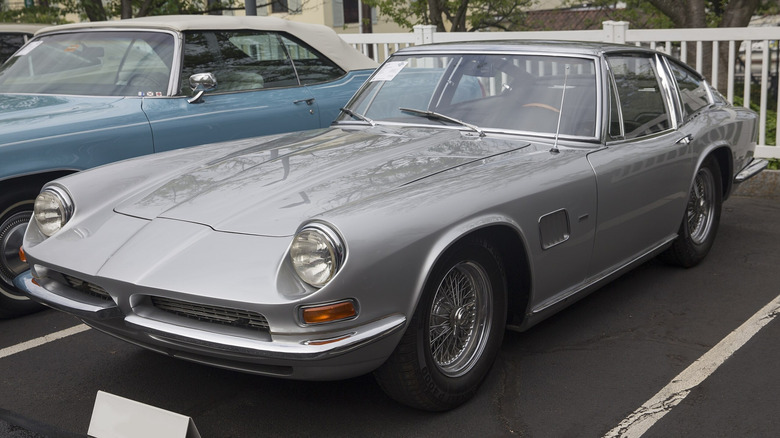
Mr.choppers/Wikimedia Commons
After a few short years of sales, Ford had already shifted its priorities away from the AC Shelby Cobra. It was focusing instead on other projects like the GT40, and so AC needed a new model to keep its business afloat. Rather than a pure sports car like the Cobra, it was decided that the potentially lucrative GT market would be the brand’s best bet, and so AC enlisted Italian styling house Frua to design a new GT based on the Cobra’s underpinnings. The Ford 428 (7.0L) V8 engine would be carried over, but this new GT would focus as much on luxury as it did on raw performance.
Advertisement
The result was the 428 Frua, a timelessly good looking British-Italian classic that retained its brawny American heart. The car was built partly in Britain and partly in Italy, which made it very expensive to buy compared to what else was on the market at the time. In turn, this helped contribute to the model’s poor sales, with only 81 examples of the car thought to have been produced. Today, the model remains significantly less valuable than a Cobra despite sharing much of its mechanicals.
[Featured image by Mr.choppers via Wikimedia Commons | Cropped and scaled | CC BY-SA 3.0]
Jensen C-V8
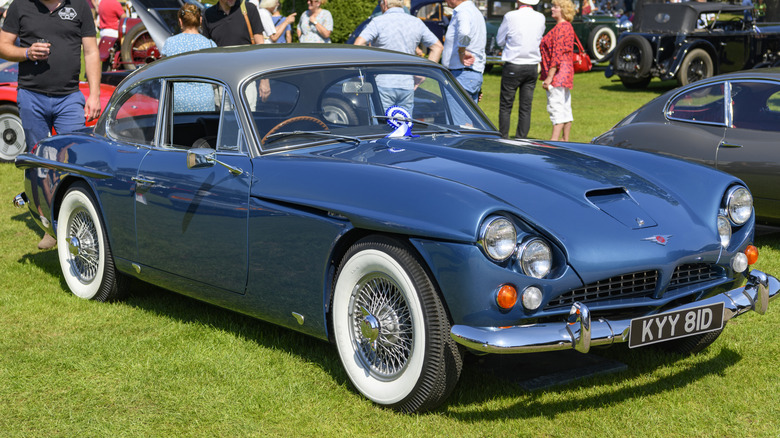
Sjoerd Van Der Wal/Getty Images
The highways of the U.K. are now mostly carpeted in speed cameras ready to automatically dish out fines to anyone who dares venture too far over the 70 mph limit. However, back when the Jensen C-V8 was unveiled, drivers often clocked much higher speeds on cross-country jaunts. That led MotorSport Magazine to declare that the car was «a splendid motorway car, cruising at 130 mph with very little wind noise» and was «the most comfortable and undemanding car imaginable for covering long distances in a minimum of elapsed time.»
Advertisement
High praise indeed, especially considering the Jensen had plenty of prestigious rivals when it was launched in 1962. Early examples of the car used a Chrysler 361 (5.9L) V8 while later models switched to 383 (6.3L) V8, with the latter churning out around 330 horsepower. In 1965, a prototype four-wheel-drive version of the car, the C-V8 FF, was produced. Jensen would incorporate four-wheel drive into its later production cars, but a production version of the C-V8 FF never materialized.
Trident Clipper
The Trident Clipper was originally intended to be a TVR, but it instead formed the basis of an ill-fated rival. The Trident, as it was initially known, was designed by Trevor Fiore and early prototypes were built by the Italian coach-builder Carrozzeria Fissore. Those early prototypes wore TVR badges, but after the carmaker declared bankruptcy in 1965, its plans to turn the prototype Trident into a production model were put on hold. Fiore claimed to have retained the rights to the car’s design and sold them to racing shop owner Bill Last, who subsequently founded Trident Motor Cars.
Advertisement
The original Trident design was built on a TVR chassis, but since TVR’s new owners weren’t too happy about having the design sold off behind their backs, they blocked Trident Motor Cars from using it. Trident had to improvise, and adapted the design to fit an Austin-Healey 3000 chassis, hence the car’s slightly awkward proportions. Power came from a Ford 289 (4.7L) V8, just as TVR had originally planned.
The design was eventually put into production as the Clipper, although an exorbitant price and questionable build quality meant that very few examples were sold. Estimates vary as to the exact number — some claim 30 Clippers were built, while Bonhams suggests as many as 39 left the factory. Either way, it wasn’t enough to sustain the business, and despite unveiling two further models based off the original design, Trident Motor Cars folded just a few years after it was formed.
Advertisement
Allard J2
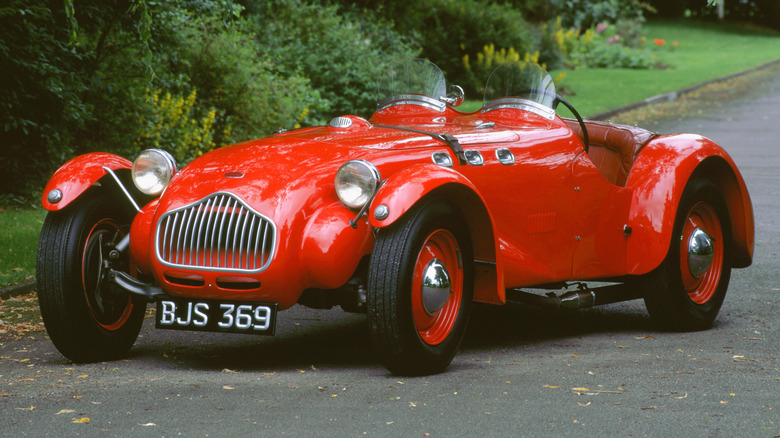
Heritage Images/Getty Images
One of the earliest proponents of the big V8/small British sports car formula was Allard, which released the J2 in 1949. Founder Sydney Allard had already been experimenting with fitting large American engines to his sports cars for years by that point, but the J2 took the formula to new levels of success. The car was fitted with a range of engines over its production run, with U.S. market examples often shipped without an engine so that the dealer could fit one of the buyer’s choice. The most common choices were V8s from Ford, Lincoln, and Cadillac.
Advertisement
For British market cars, Allard was happy to fit an engine, although again they varied between individual cars. The Allard Register reports that 90 examples of the J2 were originally built, although plenty of replicas have appeared since the last example left the factory in 1952. The car racked up a string of notable racing successes, including a third place finish at Le Mans in 1950 and a win at Watkins Glen the same year. Most racing examples featured a Cadillac 331 (5.4L) V8 engine.
Bristol 412
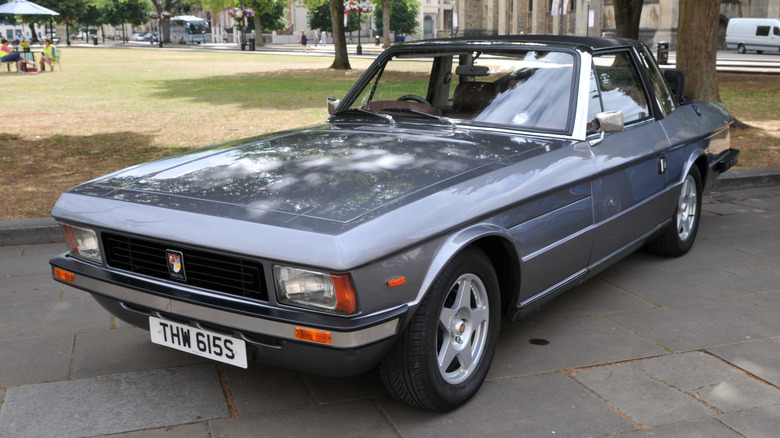
Alexander13777/Shutterstock
While it was a big departure in terms of styling from Bristol’s previous models, the Zagato-bodied 412 was a familiar beast underneath. Like every Bristol model from the 407 onwards, the 412 featured a Chrysler V8 engine under the hood, this time either a 400 (6.6L) or 360 (5.9L) depending upon its year of production. Horsepower figures were not disclosed by Bristol, but both engines were more than enough to make the 412 surprisingly rapid when needed.
Advertisement
Only a few dozen examples of the car were built, although a later turbocharged iteration called the Beaufighter added a handful more to that tally. Production of the 412 began in 1975, with the Beaufighter variant arriving in 1980. The latter would remain in production until 1992. The Beaufighter, even more so than the naturally aspirated 412, was a unique mix of old and new. It was the first British production car with a turbocharger, but was built on a chassis that had remained mostly unchanged since the 1930s. In the decades since production ended, the car has remained a largely forgotten part of the classic British motoring landscape, and as such, prices for the car remain attainable today.
Advertisement
[Featured image by Paul Wilson via Wikimedia Commons | Cropped and scaled | CC BY 2.0]
MG XPower SV
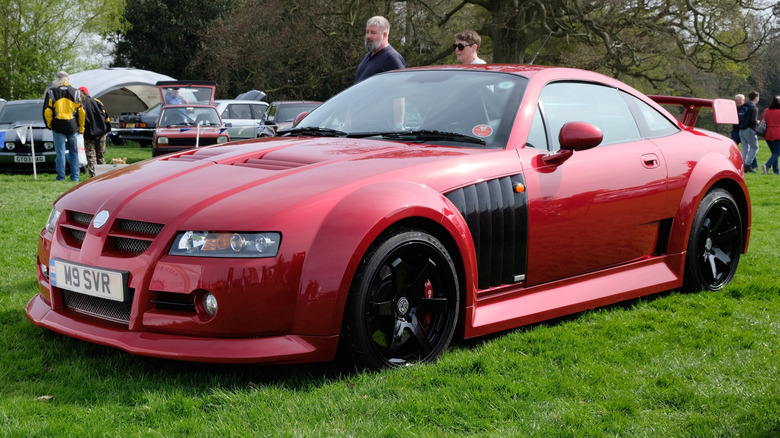
andrewbasterfield/Wikimedia Commons
While many of the most notable American-engined British cars were created in the ’60s and ’70s, brands have continued to experiment with the formula in more recent times. The MG XPower SV remains a modern classic rather than a true classic for now, being first launched in 2003, but given its unusual looks and unique backstory, it’s more than worthy of mention here.
Advertisement
The XPower SV was built on the bones of the Qvale Mangusta, the rights to which MG had recently acquired. After a thorough restyling by MG’s designers — the results of which are polarizing to put it nicely — the XPower SV was born, complete with a 4.6L Ford V8 engine. That was followed in quick succession by the XPower SV-R, complete with a 5.0L V8 built by Roush and churning out somewhere in the region of 400 horsepower.
The car’s construction was surprisingly advanced given MG Rover’s dire finances at the time, boasting Italian made carbon fiber panels, a chassis built by an Italian coachbuilder, and a race-spec roll cage. As a result, the car was far more expensive than anything else in the brand’s stable, costing the same as a well-specced Porsche 911. Yet, it was built with the same lackluster build quality as most of MG Rover’s everyday cars. Unsurprisingly, the car sold very poorly, with less than 100 examples built before the company declared bankruptcy.
Advertisement
[Featured image by andrewbasterfield via Wikimedia Commons | Cropped and scaled | CC BY-SA 2.0]